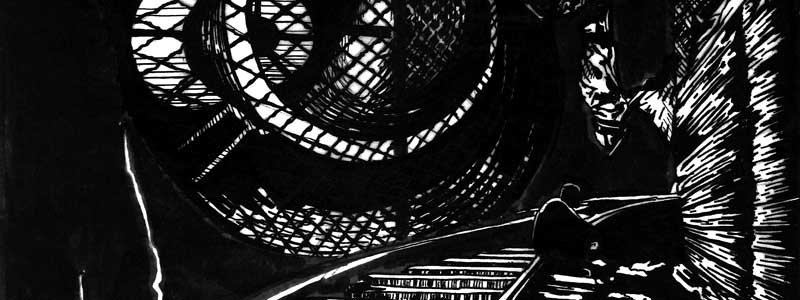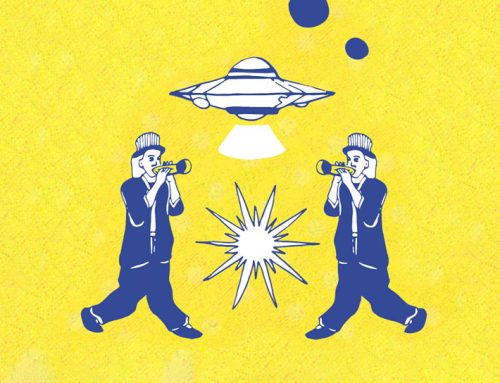Name a species less popular with Barcelonins than the cockroach. Is it Mr. Germ Bomb, the club-footed city pigeon? Or is it the Cimex pipistrelli, the little blood-sucking bed-bugger? Some might argue it’s the French bulldog but what a tough argument to sustain! Frenchies cost a fortune and can’t procreate without human help (their heads are so disproportionally large that a natural birth would kill the bitch), which makes a bulldog epidemic very unlikely. But imagine!
If you consult the Asociación Nacional de Empresas de Control de Plagas – try and make them help you with your local tourism plague! – the winner is the ratty rodent. Most pest control businesses are called in because someone is in dire need of “desratización”. The rat digs mild global-warming-winters, ever-warmer summers, uninhabited properties en venta o traspaso, bulimics, OCD daddies and the throw-away culture at large. Wash it down the toilet and they’ll eat it. Neurotic and affluent societies in times of crisis – when there’s less money to clean up our consumer crimes – provide the ideal breeding ground for the genus Rattus.
As with cockroaches (there are many kinds in Barna from the most common germánica to the americana and then the oriental), the rat is not one but multiple. And in addition to the ordinary quadrupeds that eat our garbage, there is another type that feeds on our dreams. We shall give this latter specimen the name Rattus urbex, a completely made-up pseudo-Latin term that shall henceforth denote the two-legged human Rattus variant native to Barcelona. This particular genus is mainly found in metro and Renfe tunnels once train service has been suspended for the night. Dressed in black or camouflaged as maintenance workers wearing reflective neon vests, often carrying professional cameras and tripods in unobtrusive backpacks, these bipeds explore Barcelona’s underbelly while the rest of us sleep in our innocent ignorance. “Hacemos esto para ver la ciudad de otro modo, para ensuciarnos y jugar a hacer la ratilla un rato, nada más” writes Charles of trackrunners.net before any further communication is cut off. “No nos interesa aparecer en ningun medio. […] Muchas gracias y disculpad las molestias.” Excused, Charles. You’re the most polite rat we’ve ever encountered!
A Trackrunner’s
Rattitude
[divider]
[space height=»20″]
The entire time the eyes of the surface world were watching us, continuously angry at our adventures.
– Charles, trackrunners.net
The Barcelona variety of the Rattus urbex seems to be of the active but reclusive type, and leads a dangerous and tiring double life. TMB maintenance teams, mossos, guardia urbanas and the metro patrol are after them for infiltrating and trespassing while the bosses of the surface-world wonder what to do with these sleep-deprived specimens. But what are they to say in their defense? I really had to scratch that itch and see for myself that there’s nothing left of the old Fernando L3 metro stop? Not quite. If you’re hacking into urban transport systems on a regular basis you better keep your mouth shut.
Protecting identities is sacrosanct. Expeditions happen in small packs of experienced and chiefly male individuals. Little is touched, only photos are taken, and nothing is destroyed except for maybe a lock on a grate that seals a ventilation shaft. “We don’t damage stuff. There’s enough damage on the metro system as it is, even some of the abandoned stations have paint on them” writes trackrunner on a Reddit forum and continues, “There are many ways into the tunnels. Imagination is all it takes, you’d be surprised!” And that’s the end of that story. Few urban explorers publish how-to guides or any information about entry points. If you want to try it, put on your shoes, use your common sense, enjoy the learning curve, and don’t get caught!
The prime father of this now global genus was a Canadian [s2If !is_user_logged_in()] …

Oh no, darling! No estás logged in. Per llegir tot, todo and everything, suscríbete.
[/s2If] [s2If is_user_logged_in()] known as Ninjalicious. He died as Jeff Chapman in 2005 in Toronto at age 31 – not under a train or in an air shaft but of an aggressive liver cancer. His zine Infiltration (infiltration.org) and book Access All Areas: A User’s Guide to the Art of Urban Exploring (2005), published shortly before his death, “explain the secrets of urban exploration, like sneaking, social engineering and equipping — all while guiding you through abandoned buildings, construction sites, drains, tunnels, and beyond. The book contains more than 240 pages of illustrated, expert advice.”
Knowingly and unknowingly, many have followed Ninja’s call and venture into derelict, forgotten, disused, unfinished and off-limits spaces. There’s hardly a city on this planet that isn’t populated by a pack of these “rats” nowadays. The more authorities seek to control, lock down, and protect the worlds that exist above and below street level, the more private interests encroach on public space, the stronger the interest in what lies beneath and beyond. “I believe we are an apolitical movement. I don’t think we are against the system, we’re just pointing out its limits. And as soon as the authorities realise we do, the boundaries evolve; that’s the game” quotes Bradley L. Garrett in his PhD thesis, citing fellow urban explorer Marc Explo.
If Ninjalicious is the movement’s father, Garrett is its prolific son. He is a pro who, unlike his dad, didn’t mind the limelight and so, now, has no choice in the matter having faced criminal charges at the Black Friars Crown Court for “conspiring to commit criminal damage” brought forth by the TfL, London’s TMB (the trial started on April 18th). He was the first to coin the term place-hacking, the practice of infiltrating urban spaces you’re not supposed to explore. He climbed the Shard while under construction and sent City Hall a bill afterwards for exposing security gaps; he dove deep down into the belly of Battersea Power Station, knows his way around subterranean London like no other, and currently gets his paycheck from Oxford University where he is finishing his second monograph after Explore Everything: Place-Hacking the City (Verso, 2013). If a movement that isn’t a movement needs an anti-hero, it should probably be Brad.
Hacking internationally, he has, of course, been to Barcelona – high-ranking tourist destination that we are! – to explore three metro stations with friend Dsankt (sleepycity.net – click on “contact” if you’d like to have a laugh) and Otter. They investigated what’s left of Correos metro stop, photographed the never-inaugurated Gaudí station and found a deserted encampment in the depths of Bifurcació-Vilanova in March 2012.
[gdl_icon type=»icon-question-sign» color=»#222″ size=»15px»] You were here for a weekend. I wonder about time spent on street level versus time spent above and/or below ground. Would you mind taking a wild guess as to the ratio?
Garrett: We travel to cities all over the world exploring skyscrapers, tunnels and derelict buildings and I can honestly say I know very little about those cities in any “normal” sense. If you asked me for a good restaurant in Barcelona, I would not have a clue. However, if you asked me what the best abandoned metro station is, I’d say Gaudí for sure! I guess it’s a question of how you decide what makes a city interesting. I don’t think places where you can spend money are that interesting, you can find that in any city. But there’s only one abandoned Gaudí station – it’s rare and beautiful.
[gdl_icon type=»icon-question-sign» color=»#222″ size=»15px»] You enter into the most surprising/enchanting/disgusting relationship with a city when “hacking” into its off-limits spaces but I’m afraid local authorities here in Barna are on a tidying-up spree (spatially/physically and legally). It is surely even more intense in London. What do you reckon, will there be something left to be explored in 10 years time? Will the explorers be sponsored by Red Bull so they can pay their legal fees?
Garrett: Cities are always changing and people have always been saying that cities are changing too fast. Baudelaire wrote about this in 1860 in his poem The Swan: “la forme d’une ville Change plus vite, hélas! que le coeur d’un mortel” (the form of a city Changes more quickly, alas! than the human heart). The fact of the matter is that there will always be something to explore, no matter how the city changes. The nature of exploration will also change, just like the city, as companies get more involved, sure. The biggest threat to urban exploration is not actually authorities, it’s from companies that want to co-opt the practice and undermine the message. If you get involved with them, you’ve got to do so on your own terms.
[gdl_icon type=»icon-question-sign» color=»#222″ size=»15px»] How’s the trial going?
Garrett: The trial is over! Three of the explorers had the case “stayed” by the judge, who said their prosecution was unfair. Three more had the charges against them dropped entirely. In one case, the prosecution said they “never had any evidence against him”. Two of us were given conditional discharges. So we are all free. But the police made our lives hell for two years, taking our property, stopping us from talking to each other and taking my passport. As far as I’m concerned, I was punished before I was ever tried, I spent twenty-four months in constant anxiety, cut off from my friends and family, with no property or identification… for trespassing…
Barna’s Disused Metro Stations
[divider]
[space height=»20″]
Back on Reddit, our local Rattus urbex continues: “The write up [of the Ernest Lluch interchange] will come. Right now, we’re only posting photos. No more text until the heat/fame of this story dies off. We have had over 100,000 views, 40% of those from CAT.” And what are we “CATs” so excited about, dear rat? Might it be an extraordinary photo essay featuring derelict metro stations slumbering just below our feet, telling the story of a pre-Olympic Barcelona holding her breath under Franco? (The photos are available on www.trackrunners.net/stories/disused-stations).
From Green to Yellow:
Correos
[divider]
[space height=»20″]
Correos is probably the most famous and historic of all the disused stations in this city. “Some guys have traveled a lot of miles to come here and see the old beauty that is well preserved in some parts just like the day it was closed. On one of the central columns inside the station you can find an informational poster about its closure in 1972 as well as a few advertisements from the seventies.” (trackrunners.net). The billboards show a happy couple dancing for Danone, a jeweler El Regulador on Rambla de las Flores 105 advertising joyeria and relojeria, and campaign posters for the Catalan fascist Eduard Tarragona i Corbella who ran for “Las Cortes” in 1971. “Tarragona – La voz de los sin voz” the posters tout. “Tarragona – que llama al pa, pa i al vi, vi.” Tarragona, who obviously called it as it is, won the “elections” that year.
The first trains stopped in Correos in 1934. 38 years later, in 1972, its platform was demolished to make room for a second set of tracks that would extend the now Línea 4 to Barceloneta and later on to Poblenou. “A les tres de la tarde de ayer entró en servicio la nueva estación de Ferrocarril Metropolitano, que llevará el nombre de ‘Barceloneta’ y servirá a esta populosa barriada” writes La Vanguardia on March 16th, 1976. What’s left to see for surface dwellers are 12 grates at the corner where the Correos building meets Via Laietana. This ventilation shaft was once the entrance to the station (and perhaps still serves as a point of entry?) “The following night we descended from street level into the old Correos station, surprising a load of Saturday night revelers as we disappeared before their eyes.” (Dsankt; sleepycity.net, March 2012).
Beloved and Forgotten: Fernando
[divider]
[space height=»20″]
Barcelona’s first metro line, the “Gran Metro”, inaugurated in 1924 and connected Lesseps with the city center. To put this date into perspective, London was the first city to build an underground railway in 1863 while Los Angeles’ subway didn’t open until 21 years ago! From 1946 to 1968, the Gran Metro’s last stop was Fernando, a couple hundred meters down Las Ramblas from Liceu. “This station is located just 200 meters from an active station so for sure we could have gotten to it by jumping off a platform and running into the darkness, but walking was nicer. There’s nothing more there than a poor hole without lights, but fun to reach though. The only thing that makes you recognize it as a metro station were the old exit stairs that are still there.” (trackrunners.net)
Fernando’s fate was decided when the grand “Plan de Metros” of 1966 introduced several important changes, including the L3’s extension to Drassanes, and its platforms were removed to make the green a double-track line. By that time, the two private railroad companies Gran Metropolitano de Barcelona S.A and Ferrocarril Metropolitano de Barcelona S.A. (Transversal) had merged (in 1961) into a publicly owned enterprise that we know, love and loathe today as the TMB.
Even though it was only a stone’s throw away from Liceu, the closure of Fernando wasn’t widely popular at that time. In a reader’s letter sent to La Vanguardia a neighbor complains: “Todo el vecindario de Aviñó, Plaza Real, Escudillers, etc., no irá hasta Santa Madrona para bajar en ‘Cataluña’, como hoy sucede con la estación ‘Fernando’. Y si tienen que ir hasta ‘Liceo’ es mas rápido por Pino y Puerta del Ángel llegar a ‘Cataluña’. Al otro lado de la Rambla, Unión y Conde Asalto están en situación semejante. Si hacemos una encuesta, nos demostrará que la estación ‘Fernando’, no proyectada en un principio, con colas permanentes en sus tres taquillas es más rentable que ‘Liceo’ con sólo dos taquillas abiertas e inclusive ‘Cataluña’, con sólo dos taquillas en sentido ascendente.” (Source: eltranvia48.blogspot.com.es).
Gaudí’s Lost Marbles
[divider]
[space height=»20″]
“Gaudí station ended up being the most beautiful of the set with lush marble floors and walls shockingly untouched by graffiti. If it weren’t for the trains flying through every two minutes, you would think it was 1968 […]. As we left, we turned the lights on, realized they would not turn off, and ran like hell. Gaudí reminded me why I love exploring the metro so much – big risk for big reward,” writes Bradley L. Garrett in March 2012 on placehacking.co.uk.
Some say that there’s a door in the Sagrada Familia station that leads to the abandoned platforms but you might end up in the staff changing rooms or the offices of the NGO Conductors Solidaris. Then again, you might get lucky just riding the L5 from Sagrada Familia to Hospital Sant Pau and catch a glimpse of those marble floors and ‘60s tiles thanks to some rat having hit the light switch.
Why was the station – fully equipped with elevators, fire exits and functional platforms situated between carrers Marina and Lepant – never inaugurated? Agustin del Castillo, TMB’s general director for 30 years (1978 – 2008) claimed it is too close to the current Sagrada Familia station (only 200 meters when the average distance between stops is 600 meters). But how can that have come as a surprise? It is more likely that millions of Pesetas were wasted because the rapid progress of the L5 coming down from Collblanc motivated the authorities to join this line with the already built part of the L2 that was originally planned to connect Paralel with Horta. Some things never change.
The Specter – Renfe’s Bifurcació-Vilanova
[divider]
[space height=»20″]
“Bigger tunnels built for faster trains. This train network is a beast sustained with Spanish money and it’s sometimes difficult to recognize the recent investments. There are lots of old holes in fences made by writers many, many years ago everywhere. Going trackside in Renfe you can easily spot cameras covered in dust facing walls, so who is looking at them? Lots of shit everywhere, throw-ups, lonely chairs posed for 22 bracket HDR forum click bait and furtive gardens made by retired workers. That’s the environment of this mythical place. Bifurcació-Vilanova.
I first stepped inside here many years ago and I could say that nothing has changed at all since that day. It’s a huge place, really quiet at night – disturbingly quiet perhaps. You always find yourself looking back and searching for human shapes in the shadows. It’s so big in fact that when you are in one end it’s difficult to even see where the platform ends on the other side. This station was built in 1970 to be an exchange from Renfe to metro [Arc de Triomf]. In the metro station on the surface you can still find the traces of that brotherhood between the two systems. It was originally envisioned as a huge hub station [to replace] Estació del Nord but it was never opened to the public. A big space virtually occupied by an enormous platform covered in dust and full of holes, completed by a pair of elevators.” (April 2014, trackrunners.net).
Exploring the depth of the station further, Bradley L. Garrett writes: “Our greatest surprise was not to be found on the platforms. Deep in the station, we ran into a homeless encampment. The occupant had clearly died some time ago. His possessions, including loose change, were laid out on the side table as if he had just gone out to get snacks or smack and never returned. In all the places I have seen in my time exploring dereliction, nothing had prepared me for this – the place was thickly haunted. We challenged those ghosts, and our fears, by opening the treasure boxes there and discovered an ID. It made it more deeply terrifying to see the name and photo of the specter.” (March 2012, placehacking.co.uk ).
The trackrunners came across this “thickly haunted” encampment as well – some two years later – and named the ghost “Metro Gandalf”. They too wondered what would bring a person to crawl that deep into a city’s intestines. Was he eating rats or did rats eat him? Was he feeding on our dreams or are we feeding on his?
Terminal Stop:
The Superficial Surface-Dwellers
[divider]
[space height=»20″]
Of course, the list of abandoned stations doesn’t end with Bifuració-Vilanova. There’s Banc (between Jaume I and Urquinaona) that urban legends claim was used to transport Catalan money to Madrid – and that some argue still exists. There are Travessera, Ferran, Santa Eulàlia, Ernest Lluch and the list continues along a meandering timeline of 90 years of tunnel digging and urban planning.
The further down you dive into the “underground” and Barcelona’s subterranean past, the more you realize that a vertical imagination is missing from the way we experience this – our – city today. Look at any map and what you see is pure surface. The most ordinary and utilitarian, like your go-to Google Map, is also the most radically distorted. It is profoundly oriented toward transportation, will calculate in milliseconds how to get you from A to B on foot, by car or public transport, and will guide you efficiently along the designated paths. If you stare at it long enough you might hear it whisper: “The less you stray, the better a citizen you are”.
So, while Plaça Catalunya has disappeared under layers of iPhone advertisements and we hold our breath in wait for this year’s tourism flood to ebb away, there are a bunch of two-legged rats out there working on a different type of map. It’s informal, illegal and it doesn’t have a zoom button, but it has many more dimensions than its Google counterpart.
If you don’t discard the Rattus urbex as completely mad, you must allow for the possibility that this genus is driven by an insatiable appetite to more fully experience this city – all its dimensions, all its dirty little secrets, forgotten stories and lost souls. And since this species is respectful of the place itself, if not the boundaries that authorities and property owners impose, you can’t really pigeonhole their behavior as vandalism. It is not an aggressive but a transgressive attitude that drives this pack. Some might say it’s a healthy antiauthoritarian mindset, others think it’s foolish and suicidal. Just know that it goes both ways and there are some rats out there who believe us surface dwellers to be a boring, passive bunch of HBO-addicts who know nothing about this city or this life – as profound as the Google Map we use every day.
Call them what you may, give them made-up Latin names like Rattus urbex. Label them as modern-day archeologists and historians, infiltrators, trespassers, lawless egocentrics or simply rats. One thing is for sure: as new territories are explored and boundaries are breeched, the ajuntament is thinking of ways to control the “plague”. But as any and every pest control company will tell you, you can’t rid a city of its rats. You can only try to control their population. And, on that note, good night and good luck, Rattus urbex. Don’t get caught and keep us posted. We might find your search more political than you do.[/s2If]








